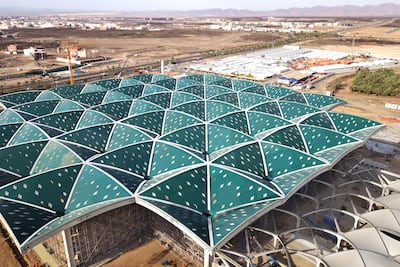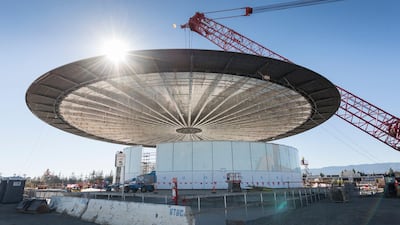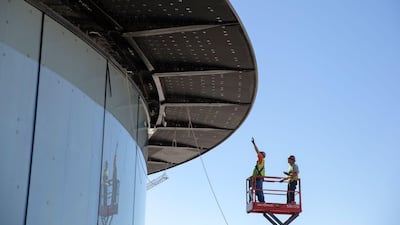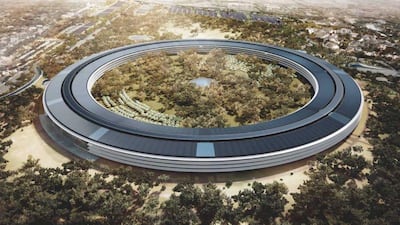You’ve most likely never heard of it, but some of the world’s most iconic buildings bear the signature of this Dubai-based technology company.
The most spectacular addition to these resembles nothing less than a UFO coming into land. The saucer-shaped roof of the Steve Jobs Theater at Apple’s new headquarters in Cupertino, California is an 80-tonne disc composed of 44 identical carbon-fibre panels and built by Premier Composite Technologies (PCT), which is based in Dubai Investment Park.
Lowered into place, the roof is now billed as the world’s largest freestanding carbon-fibre roof and sits on top of the 1,200 seat subterranean auditorium which is expected to be the stage for future announcements about Apple and its products.
It is not the first time the two companies have worked together. Much closer to home, PCT was responsible for the construction of 18 motorised “wings” at the new Apple store in Dubai Mall.
Nearly 12 metres high, the motorised solar wings, which are inspired by the traditional Arabic mashrabiya, can swing open and shut, depending on environmental conditions.
While the roots of PCT are building yacht hulls, the company has become recognised as a world leader in supplying and manufacturing composite components, which are both strong and lightweight.
These now include a deal with Mubadala’s aerospace division Strata, in Al Ain, where PCT has been awarded a Dh60 million contract for the “honeycomb” composite cores that Strata incorporates into the wing flaps it is building for the Airbus A380 superjumbo.
It is in the field of construction, though, that PCT, which was founded in 2006 and now employs around 2,400 workers, has really made its mark.
Pilgrims to Mecca will be especially familiar with its work. To relieve congestion around the Kaaba and the Great Mosque, the Saudi authorities commissioned two colossal walkways to encompass the holy site.
Twelve meters wide and up to 13 metres high, the two rings are the largest carbon-fibre civic structures in the world. To build them, the Dubai company needed to supply parts that were accurate to a millimetre, capable of safely supporting up to 35,000 worshippers as they circle Islam’s most sacred site.
If they look towards the sky, visitors cannot miss the massive Dokaae Clock Tower, the largest timepiece in the world, and the golden crescent which tops it. Here the company supplied both the cladding and the clock faces, which are visible from a distance of eight kilometres.
The challenge was to make the materials as light as possible, since putting them in place required lifting the elements of the clock to a height of nearly 400 metres.

In Medina, PTC was involved in the transformation of the Haram Plaza, with 250 huge 25-metre-wide umbrellas offering shade to pilgrims even when Haj falls in the summer months.
It has also supplied panels for the spectacular concourse at Medina Station, part of Saudi Arabia’s high-speed rail link that connects the burial place of the Prophet Mohammed with Mecca and Jeddah.
Outside the Middle East, the Dubai firm created 150 advanced composite panels for the dome of Angola’s new assembly hall. With a diameter of 42 metres and a height of around 23 metres, the dome is the largest PTC has ever built.
In Turkmenistan it produced light-weight panels for the dome of the Astelco Telescope. Unfolding like the petals of a flower, the panels allow the telescope inside to search the night skies.
One of the most unusual projects was an art installation on the island of San Giorgio Maggiore in the Venice Lagoon. Sky Over Nine Columns is an art installation featuring nine gold columns, each seven metres tall.
The sculpture, by the German artist Heinz Mack, is one of the few examples of the company’s work whose whereabouts is uncertain. Created for the 2014 Venice Biennale, the columns were dismantled after the art show in November 2014 and were last seen this winter in the fashionable Swiss ski resort of San Moritz.




![[Missing Caption]](https://www.thenationalnews.com/resizer/v2/ZDU6BVWU2L5ABOGIYA5UJR7YXY.jpg?smart=true&auth=a6d56716b3f025e1a337ee878f29cdd2ba56f7fd3e7ac1f2f7b62602e83135b1&width=400&height=267)
